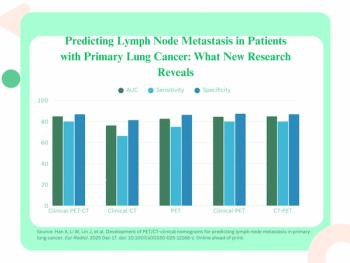Could earlier use of prostate-specific membrane antigen (PSMA) positron emission tomography/computed tomography (PET/CT) enhance decision-making beyond the use of multiparametric MRI (mpMRI) for patients with newly diagnosed prostate cancer (PCa)?
For a new phase 2 prospective study, recently published in the Journal of Nuclear Medicine, researchers compared the use of PSMA PET/CT and mpMRI in 230 biopsy- and imaging-naïve men with suspected PCa. The study authors noted that the two imaging modalities were employed for all men prior to targeted ultrasound fusion and systematic biopsy. Out of the 137 men diagnosed with PCa, 35 percent had intermediate-risk PCa, 15 percent had high-risk disease and 9 percent had low-risk PCa, according to the study.
The study authors found that PSMA PET/CT changed the treatment plan for 34 percent of patients diagnosed with PCa. In addition to changes in local treatments such as lymph node dissection (16 percent) and nerve-sparing procedures (18 percent), the researchers noted that 28 percent of the patients had radiation field adjustments.
“We demonstrate that early PSMA PET/CT staging can influence treatment decisions in up to one third of patients with PCa by providing additional characterization of tumor extent and grade through imaging and targeted biopsy," wrote lead study author Philipp Krausewitz, M.D., who is affiliated with the Department of Urology and Pediatric Urology at the University Hospital Bonn in Bonn, Germany, and colleagues.
"Treatment changes occur not only in patients with high-risk disease but also in a substantial subset of patients with intermediate-risk disease — particularly those with unfavorable features such as high PSA density and suggestive DRE findings — with patient selection feasible using clinical parameters and mpMRI."
In cases involving PSMA PET/CT influenced treatment plan changes, the researchers pointed out that these patients had more suggestive findings from digital rectal exams (DREs), higher prostate-specific antigen (PSA) levels and higher PI-RADS scores. Multivariable analysis indicated that patients with suggestive DRE findings and elevated PSA density were nearly 2.5-times more likely to have treatment plan changes influenced by PSMA PET/CT, according to the researchers.
Using triple biopsy as a reference standard, researchers noted a 16 percent higher sensitivity rate for PSMA PET/CT in comparison to mpMRI for clinically significant prostate cancer (csPCa) (98 percent vs. 82 percent). However, they also pointed a 55 percent higher specificity rate for mpMRI (60 percent vs. 5 percent).
“Its limited specificity and negative predictive value constrain its utility as a standalone, upfront imaging modality. Therefore, despite growing evidence supporting PSMA PET/CT for local tumor characterization, further refinement remains necessary,” added Krausewitz and colleagues.
Three Key Takeaways
• Early PSMA PET/CT influences management. Incorporating PSMA PET/CT prior to biopsy altered treatment plans in approximately one-third (34 percent) of newly diagnosed prostate cancer patients, impacting surgical and radiation planning beyond mpMRI findings.
• Improved sensitivity but lower specificity. PSMA PET/CT showed higher sensitivity for clinically significant prostate cancer (98 percent vs. 82 percent) compared to mpMRI, though mpMRI maintained much higher specificity (60 percent vs. 5 percent), underscoring complementary rather than standalone use.
• Added value in equivocal or negative mpMRI cases. PSMA PET/CT detected csPCa in 22 percent of patients with negative or inconclusive mpMRI, highlighting its potential role in guiding biopsy decisions for patients with persistent clinical suspicion.
The study findings also revealed that the combined use of mpMRI and PSMA PET/CT yielded an 89 percent detection rate for csPCa. Researchers also noted that PSMA PET/CT identified csPCa in 22 percent of cases with negative or unequivocal findings on mpMRI.
“Consistent with prior studies, our data highlight that in challenging cases with negative or inconclusive MRI but persistent clinical suggestion, PSMA PET/CT provides additional information to guide biopsy decisions,” maintained Krausewitz and colleagues.
(Editor’s note: For related content, see “Nine Takeaways from New Review of PSMA PET/CT and Whole-Body MRI for Advanced Prostate Cancer,” “Meta-Analysis Shows Benefits of PSMA PET in Detecting Recurrence and Metastasis with PCa” and “Study Emphasizes PSA and PSMA PET Tumor Volume Assessment for Predicting mHSPC Progression After Apalutamide and ADT.”)
In regard to study limitations, the authors cautioned against broad extrapolation of the findings with 68Ga-PSMA-11 PET/CT to other PSMA-based tracers. They also acknowledged the lack of follow-up data to assess the impact of the initial PSMA PET/CT on long-term treatment outcomes. The researchers also noted that limited access, increased costs and increased diagnostic workload may thwart wider adoption of PSMA PET/CT.





























